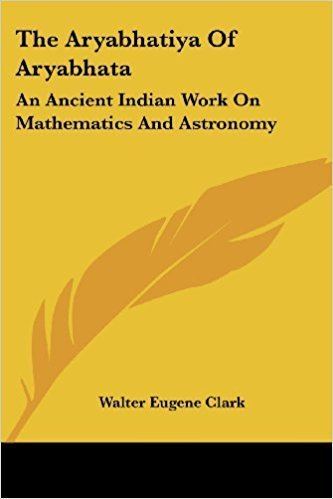 | ||
Similar Surya Siddhanta, Baudhayana sutras, Kātyāyana | ||
Aryabhatiya (IAST: Āryabhaṭīya) or Aryabhatiyam (Āryabhaṭīyaṃ), a Sanskrit astronomical treatise, is the magnum opus and only known surviving work of the 5th century Indian mathematician, Aryabhata.
Contents
Structure and style
The text is written in Sanskrit and divided into four sections, covering a total of 121 verses that describe different results using a mnemonic style typical for such works in India.
1. Gitikapada: (13 verses): large units of time—kalpa, manvantra, and yuga—which present a cosmology different from earlier texts such as Lagadha's Vedanga Jyotisha(ca. 1st century BCE). There is also a table of sines (jya), given in a single verse. The duration of the planetary revolutions during a mahayuga is given as 4.32 million years.
2. Ganitapada (33 verses): covering mensuration (kṣetra vyāvahāra), arithmetic and geometric progressions, gnomon / shadows (shanku-chhAyA), simple, quadratic, simultaneous, and indeterminate equations (kuTTaka)
3. Kalakriyapada (25 verses): different units of time and a method for determining the positions of planets for a given day, calculations concerning the intercalary month (adhikamAsa), kShaya-tithis, and a seven-day week with names for the days of week.
4. Golapada (50 verses): Geometric/trigonometric aspects of the celestial sphere, features of the ecliptic, celestial equator, node, shape of the earth, cause of day and night, rising of zodiacal signs on horizon, etc. In addition, some versions cite a few colophons added at the end, extolling the virtues of the work, etc.
It is highly likely that the study of the Aryabhatiya was meant to be accompanied by the teachings of a well-versed tutor. While some of the verses have a logical flow, some don't and its lack of coherence makes it extremely difficult for a casual reader to follow.
Indian mathematical works often used word numerals before Aryabhata, but the Aryabhatiya is the oldest extant Indian work with alphabet numerals. That is, he used letters of the alphabet to form words with consonants giving digits and vowels denoting place value. This innovation allows for advanced arithmetical computations which would have been considerably more difficult without it. At the same time, this system of numeration allows for poetic license even in the author's choice of numbers. Cf. Aryabhata numeration, the Sanskrit numerals.
Contents
The Aryabhatiya contains 4 sections or Adhyāyās. The first section is called Gītīkāpāḍaṃ.It has 13 slokas. Aryabhatiya begins with an introduction called the "Dasageethika" or "Ten Stanzas." This begins by paying tribute to Brahman (not Brāhman), the "Cosmic spirit" in Hinduism. Next, Aryabhata lays out the numeration system used in the work. It includes a listing of astronomical constants and the sine table. The book then goes on to give an overview of Aryabhata's astronomical findings.
Most of the mathematics is contained in the next part, the "Ganitapada" or "Mathematics."
The next section is the "Kalakriya" or "The Reckoning of Time." In it, he divides up days, months, and years according to the movement of celestial bodies. He divides up history astrologically—it is from this exposition that historians calculated a date of AD 499 for the compilation of the Aryabhatiya. It also contains rules for computing the longitudes of planets using eccentrics and epicycles.
In the final section, the "Gola" or "The Sphere," Aryabhata goes into great detail describing the celestial relationship between the Earth and the cosmos. This section is noted for describing the rotation of the earth on its axis. It further uses the armillary sphere and details rules relating to problems of trigonometry and the computation of eclipses.
Significance
The treatise uses a geocentric model of the solar system, in which the Sun and Moon are each carried by epicycles which in turn revolve around the Earth. In this model, which is also found in the Paitāmahasiddhānta (ca. AD 425), the motions of the planets are each governed by two epicycles, a smaller manda (slow) epicycle and a larger śīghra (fast) epicycle.
It has been suggested by some commentators, most notably B. L. van der Waerden, that certain aspects of Aryabhata's geocentric model suggest the influence of an unknown, underlying heliocentric model. This view has been contradicted by others and, in particular, strongly criticized by Noel Swerdlow, who characterized it as flatly contradicting Aryabhata's own words.
Aryabhata asserted that the Moon, planets, and asterisms shine by reflected sunlight. He also correctly explained the causes of eclipses of the Sun and the Moon. His value for the length of the sidereal year at 365 days 6 hours 12 minutes 30 seconds is only 3 minutes 20 seconds longer than the modern scientific value of 365 days 6 hours 9 minutes 10 seconds. In this book, the day was reckoned from one sunrise to the next, whereas in his "Āryabhata-siddhānta" he took the day from one midnight to another. There was also difference in some astronomical parameters.
A close approximation to π is given as : "Add four to one hundred, multiply by eight and then add sixty-two thousand. The result is approximately the circumference of a circle of diameter twenty thousand. By this rule the relation of the circumference to diameter is given." In other words, π ≈ 62832/20000 = 3.1416, correct to four rounded-off decimal places.
Influence
Most notable Indian mathematicians after Aryabhata wrote commentaries on it. At least twelve notable commentaries were written for the Aryabhatiya ranging from the time he was still alive (c. 525) through 1900 ("Aryabhata I" 150-2). The commentators include Bhāskara I and Brahmagupta among other notables.
The estimate of the diameter of the Earth in the Tarkīb al‐aflāk of Yaqūb ibn Tāriq, of 2,100 farsakhs, appears to be derived from the estimate of the diameter of the Earth in the Aryabhatiya of 1,050 yojanas.
The work was translated into Arabic around 820 by Al-Khwarizmi, whose On the Calculation with Hindu Numerals was in turn influential in the adoption of the Hindu-Arabic numerals in Europe from the 12th century.
Aryabhata's methods of astronomical calculations have been in continuous use for practical purposes of fixing the Panchangam (Hindu calendar)
